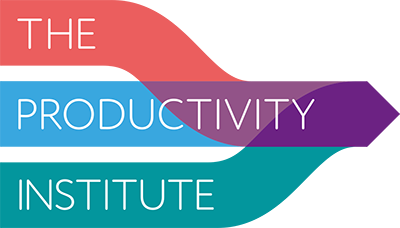Making Productivity Strategic
 Reflections on National Productivity Week 2025
Reflections on National Productivity Week 2025
BART VAN ARK
Improving business performance through productivity is a powerful concept. To make it effective, business leaders need to create a compelling story about why productivity is important. This involves understanding its key drivers and finding ways to connect different aspects of productivity improvement in the boardroom.
Poor productivity growth is a significant issue for both government and businesses. Productivity is likely the most crucial factor for reigniting economic growth in the UK and beyond. During National Productivity Week 2025, TPI’s second awareness campaign aimed at placing productivity at the core of the UK’s growth mission, there was widespread agreement that government, businesses, and individuals all play a vital role in the solution.
But from a business perspective, do leaders really view productivity as their issue? “I don’t do productivity”, a business leader recently told me. “I focus on producing goods that sell well and managing costs to make a profit. If that’s what you call productivity, then I’m fine with it.” While perhaps not as precise as a student of productivity would like it – it’s an excellent starting point for a meaningful conversation on business productivity.
Productivity and efficiency
Productivity and efficiency aren’t the same, but in a competitive market, they go hand in hand. Productivity is all about getting more output from each unit of input, while efficiency focuses on reducing resource use relative to output. The most productive companies are those that manage and combine their limited resources—like people, money, and technology—in a cost-effective way to create products and services that customers value.
These companies grow both their revenue and profits, freeing up resources to reward investors and workers and make room for new investments. Productive companies typically have the capacity to not only improve themselves but also support their business partners in the supply chain and contribute positively to their local communities. This creates a win-win situation for everyone involved, forming what we call a productivity ecosystem.
What does productivity at the organisational level mean?
Interestingly, surveys and interviews with business leaders indicate that productivity is not consistently utilised as a key performance indicator (KPI), particularly at the organisational level. To be clear, this doesn’t mean successful businesses aren’t working to standardise processes and make them more efficient. With the huge advances in data technologies, almost every part of the production process can now be measured for efficiency. Real-time big data and data processing technologies, including artificial intelligence to predict patterns and address potential issues before they arise, offer vast opportunities for business to raise productivity.
But when we look at productivity at the organisational level, it’s about more than just the efficiency of the production line or service delivery. Organisations have many people and resources that aren’t directly involved in production but still play a crucial role in creating value. Indirect functions include finance, human resources (HR), research and development (R&D), sales and marketing, and general management. A tech company, for instance, might have software engineers coding new features, but its overall productivity also depends on customer support teams, cybersecurity specialists, compliance officers, and project managers who keep things running smoothly. In production companies, indirect labour might account for 20 to 30 percent of all labour costs, but in service companies, it’s often much higher. Plus, many production firms today are also offering more pre- and post-sales services as part of their overall process.
It’s often tricky to define and measure the productivity of teams that contribute indirectly to the production process. Including these indirect inputs in the productivity equation as overhead or indirect costs can sometimes make them seem like a burden rather than a valuable contributor. Moreover, simply measuring revenue per person doesn’t really help us understand what’s driving productivity, and risks taking arbitrary decisions on what may be key productivity drivers.
Creating a productivity narrative
So where to start to make productivity relevant for the entire business? While multiple metrics are needed, a better starting point is for business leaders to create a narrative around what productivity means to them and to their business. Which outputs matter most to the company’s success? Is it revenue, volumes, customer satisfaction, or market penetration? And which inputs are the most critical? Is it the people, their skills or motivation, key materials, technologies, or equipment? And what are the best ways to combine these inputs to create better outputs? Is automation or AI always the answer? How should people be trained to best adopt those new innovations? Does a more sustainable transformation of inputs to outputs make the production process more resilient?
There are many ways to talk about productivity, but before an organisation can start measuring it, it needs a clear story about how it wants to be productive. This narrative should be part of the company’s value proposition, outlining its goals and approach to productivity.
Identifying the key productivity drivers
It’s often said, “There is no silver bullet to the productivity puzzle.” This is true not only for the slow productivity growth of the entire economy but also for improving productivity within a business. The Productivity Institute’s (TPI) research on Strategic Productivity has identified five key drivers of business productivity.
First, leveraging the latest technology and innovative ideas can streamline operations and enhance products. It’s also crucial to have a team that’s not only skilled but happy and healthy. Effective leadership and agile management practices set the tone for a productive workplace, while clear and engaging communication, both internally and externally, is essential. Lastly, mobilising the necessary funds to invest in growth and improvements is key.
When these five drivers and their sub-components are aligned and working together, they can really boost productivity. However, there’s no one-size-fits-all approach to combining these drivers. It all depends on the sector, the product mix, the company’s maturity, and, most importantly, where the company wants to go—back to the narrative.
Joining up the productivity drivers
The secret sauce to strategic productivity is connecting the different perspectives within a company. Over the past two years, TPI has conducted research focusing on productivity from the angles of Human Resources, Information Technology, and Finance. Through surveys, interviews, and focus groups, we explored how each function views productivity in their role and how they contribute to the overall productivity of the organisation.
Interestingly, we found a lot of frustration among business leaders. For example, CHROs focus on the people aspect of productivity but struggle to explain its importance compared to other productivity drivers. CIOs feel there’s a lack of understanding across the organisation about what it takes to implement new technology effectively. CFOs have to juggle being the financial gatekeeper while also driving business value as a commercially savvy leader. These perspectives can be brought together in the boardroom to create a more cohesive approach to productivity.
An opportunity for better growth
So should we be concerned that many firms “don’t do productivity” at the level of the organisation? At TPI we have learned from our research and conversations with business leaders that organisations are becoming more complex and are trying to navigate a rapidly changing and uncertain environment. There is also a “fear of missing out” (FOMO), especially with new technologies emerging that can easily lead to misalignment of the productivity drivers.
Strategic productivity provides an opportunity to refine business strategy beyond just focusing on the top and bottom lines. It requires a clear narrative and actionable steps to efficiently and effectively transform limited resources, thereby enhancing value delivery and sustaining long-term growth. This approach necessitates the involvement of all parts of the firm and should be a central focus for business leadership.
Find out more
If you are interested in finding out more about productivity within your organisation, sign up to our Strategic Productivity Executive Education course at Alliance Manchester Business School. There are limited spaces available for the April course, being held 8–11 April, with a 50% discount for organisations within Greater Manchester.





